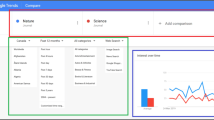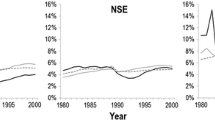Abstract
Nature is among the world’s most highly cited multidisciplinary science journals with one of the highest impact factors of 38.597 (Nature Publishing Group (NPG) 2013), which is used relatively often in many scientific rankings. When analysing the regional distribution of Nature publications, we found a high correlation between the expenditures and the number of local affiliations that are counted on a national basis. The same regularity can be observed for the world’s top 30 and the US’s top 50 universities; however, the correlation is now skewed by the so-called cumulative advantage or the Matthew Effect, which evidently rewards those that are ranked at the top of the Academic Ranking of World Universities. The rich get richer and the poor get poorer. Surprisingly, the amount of the endowment better determines the number of Nature publications for universities than the total research expenditure.









Similar content being viewed by others
References
Arkhipov, D. B. (1999). Scientometic analysis of Nature, the journal. Scientometrics, 46(1), 51–72.
Broberger, C., & Sjostrom Douagi, A. (2012). Funding model: Cuts endanger young scientists in Europe. Nature, 491, 672.
Frame, J. D., & Narin, F. (1976). NIH funding and biomedical publication output. Federal Proceedings, 35, 2529–2532.
Garrison, H. H. (2013). Research funding: Fiscal cliff is bad news for US science. Nature, 493, 163.
Gross, C., Anderson, G., & Powe, N. (1999). The relation between funding by the national institutes of health and the burden of disease? New England Journal of Medicine, 340(24), 1881–1887.
Guan, J., & Wang, J. (2004). Evaluation and interpretation of knowledge production efficiency. Scientometrics, 59(1), 131–155.
ITG. (2008). The Science of Science Policy: A Federal Research Roadmap. Washington, DC: National Science and Technology Council and the Office of Science and Technology Policy.
Kaneiwa, K., Adachi, J., Aoki, M., Masuda, T., Midorikawa, N., Tanimura, A., et al. (1988). A comparison between the journals Nature and Science. Scientometrics, 13(3–4), 125–133.
Keene, O. N. (1995). The log transformation is special. Statistical Medicine, 14, 811–819.
Leydesdorff, L., & Wagner, C. (2009a). Is the United States losing ground in science? A global perspective on the world science system. Scientometrics, 78(1), 23–36.
Leydesdorff, L., & Wagner, C. (2009b). Macro-level indicators of the relations between research funding and research output. Journal of Informetrics, 3, 353–362.
Matthew 25:29. The Holy Bible. King James Version. Retrieved from http://lds.org/scriptures/nt/matt/25?lang=eng.
McMahon, M. (2013). What is an endowment ? wiseGEEK, Conjecture Corp. Retrieved from http://wisegeek.com/what-is-an-endowment.htm. Accessed July 2013.
Merton, R. K. (1968). The Matthew effect in science: The reward and communication systems of science are considered. Science, 159(3810), 56–63.
Moran, M., Guzman, J., Ropars, A. L., McDonald, A., Jameson, N., Omune, B., et al. (2009). Neglected disease research and development: How much are we really spending? PLoS Medicine, 6(2), e1000030.
Morrison, R. T., & Boyd, R. N. (1973). Organic Chemistry (3rd ed., p. 188). Boston: Allyn & Bacon Inc.
National Institutes of Health (NIH). (2011). Estimates of funding for various diseases, conditions, research areas. National Institutes of Health, Department of Health and Human Services. Retrieved from http://report.nih.gov/categorical_spending.aspx. Accessed May 2013.
National Science Board (NSB). (2012). Science and Engineering Indicators overview. Washington, DC: National Science Foundation. Retrieved from http://nsf.gov/statistics/seind12/c0/c0i.htm. Accessed July 2013.
Nature Publishing Group (NPG). (2013). Nature Publishing Index 2012 Global. London: Macmillan Publisher Limited. Retrieved from http://natureasia.com/en/publishing-index. Accessed May–July 2013.
Shermer, M. (2008). The mind of the market: Compassionate apes, competitive humans and other tales from evolutionary economics. New York: Henry Holt and Company.
Symonds, M. (2004). Nature and Science know best. Trends in Ecology and Evolution, 19(11), 564.
Tol, R. S. J. (2009). The Matthew effect defined and tested for the 100 most prolific economists. Journal of the American Society for Information Science and Technology, 60(2), 420–426.
Tol, R. S. J. (2013). The Matthew effect for cohorts of economists. Journal of Informetrics, 7, 522–527.
Vanderelst, D., & Speybroeck, N. (2013). Scientometrics reveals funding priorities in medical research policy. Journal of Informetrics, 7, 240–247.
Venables, W. N., & Ripley, B. D. (2002). Modern applied statistics with S (4th ed.). New York: Springer. ISBN 0-387-95457-0.
Acknowledgements
J. Bogocz appreciates the support of the Doktoris fellowship.
Author information
Authors and Affiliations
Corresponding author
Electronic supplementary material
Below is the link to the electronic supplementary material.
Rights and permissions
About this article
Cite this article
Bogocz, J., Bak, A. & Polanski, J. No free lunches in nature? An analysis of the regional distribution of the affiliations of Nature publications. Scientometrics 101, 547–568 (2014). https://doi.org/10.1007/s11192-014-1252-4
Received:
Published:
Issue Date:
DOI: https://doi.org/10.1007/s11192-014-1252-4




